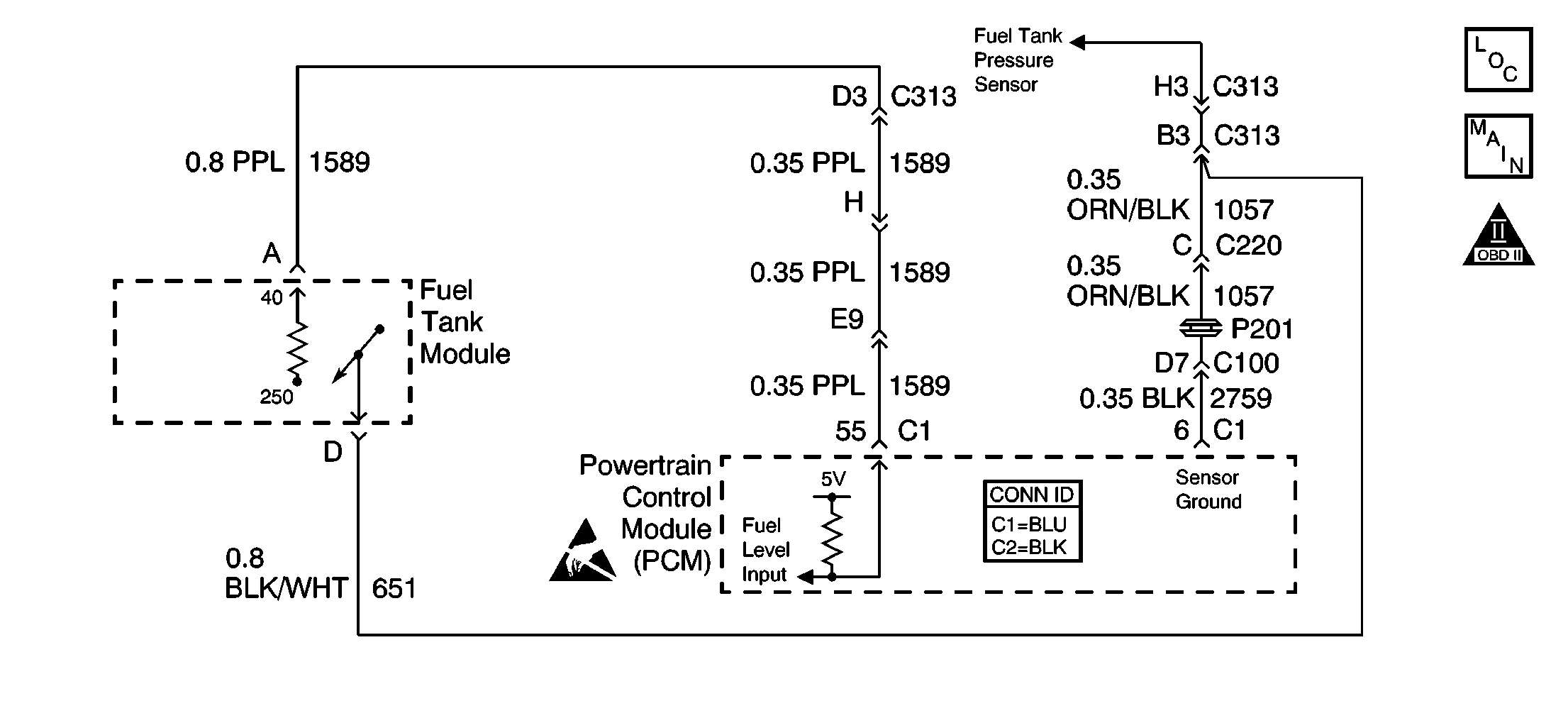
Circuit Description
The PCM uses a fuel level input in order to calculate the expected vapor pressures within the fuel system. These vapor pressure vary as the fuel level changes. The vapor pressure is critical in determining if the evaporative emission (EVAP) system is operating properly. The PCM also uses the fuel level in order to determine if the fuel level is too high or too low to be able to accurately detect an EVAP system malfunction.
Conditions for Running the DTC
| • | The ignition is ON. |
| • | The system voltage is between 11 and 16 volts. |
Conditions for Setting the DTC
Fuel level has not changed more than 1.6 percent in 193 km (120 miles).
Action Taken When the DTC Sets
| • | The PCM will record the operating conditions during the time which the diagnostic fails. This information will store in the Failure Records buffer. |
| • | A history DTC stores. |
| • | The fuel level will default to 40 percent. |
Conditions for Clearing the DTC
| • | A history DTC clears after 40 consecutive warm up cycles without a fault. |
| • | Use a scan tool to clear the DTCs. |
Diagnostic Aids
| • | Inspect for the following conditions that may cause intermittents: |
| - | Poor electrical connections |
| - | Rubbed through wire insulation |
| - | A wire that is broken inside the wire insulation |
| • | Thoroughly inspect any circuitry that is suspected as causing the intermittent complaint. Inspect for the following conditions: |
| - | Backed out terminals |
| - | Improper mating |
| - | Broken locks |
| - | Improperly formed or damaged terminals |
| - | Poor terminal to wire connections |
| • | Before replacing the PCM, inspect the PCM electrical connector terminals for the following conditions: |
| - | Improper mating |
| - | Broken locks |
| - | Physical damage to the wiring harness |
Test Description
The numbers below refer to the step numbers on the diagnostic table.
-
The Powertrain OBD System Check prompts you to complete some of the basic checks and to store the freeze frame and failure records data on the scan tool if applicable. This creates an electronic copy of the data captured when the malfunction occurred. The scan tool stores this data for later reference.
-
Replacement PCMs must be reprogrammed and the crankshaft position system variation procedure must be performed. Refer to the latest Techline information for programming procedures.
Step | Action | Value(s) | Yes | No | ||||
|---|---|---|---|---|---|---|---|---|
Did you perform the Powertrain On-Board Diagnostic (OBD) System Check? | -- | |||||||
2 |
Are DTCs P0462 or P0463 set? | -- | Go to DTC P0462 Fuel Level Sensor Circuit Low Voltage or to DTC P0463 Fuel Level Sensor Circuit High Voltage | |||||
3 |
Does the scan tool indicate the specified level? | 100% | ||||||
4 | Connect a jumper wire between the following circuits:
Does the scan tool display the specified value. | 0% | ||||||
5 |
Was a repair necessary? | -- | ||||||
6 |
Does the test light illuminate? | -- | ||||||
7 |
Was a repair necessary? | -- | ||||||
8 |
Was a repair necessary? | -- | ||||||
Important: The replacement PCM must be programmed. Refer to Powertrain Control Module Replacement/Programming . Did yoe complete the repair? | -- | -- | ||||||
10 |
Was the repair necessary? | -- | ||||||
11 |
Is the action complete? | -- | -- | |||||
12 |
Does the scan tool indicate that this diagnostic has ran and passed? | -- | ||||||
13 | Determine if any additional DTCs are set. Does the scan tool display any DTCs that have not been diagnosed? | -- | Go to the applicable DTC table | System OK |
